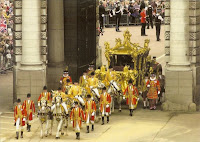Who is the Duke of Edinburgh? Born Prince Phillip of Greece
and Denmark in 1921 to the royal house of Schleswig-Holstein-Sonderburg-Glücksburg,
he and his family, including his mother, a British princess and his father, a
brother of the King of Greece, were exiled from the country of his birth and he
went on to study in Britain and to become a naval officer in the Royal Navy
serving in the Second World War. But most famously and arguably most
importantly, His Royal Highness Prince Phillip, The Duke of Edinburgh is the
husband of our own Queen Elizabeth II.
After meeting the then Princess Elizabeth, daughter of King
George VI in 193 4, they were to marry in 1947,
five years before his wife became queen, making him the longest serving
consort to a monarch in British history. And this is why it is all th
e more
disturbing that for the third time in a year, His Royal Highness was admitted
to hospital almost two weeks ago. Although he has now left hospital following
what was publicly announced as an investigative abdominal operation, it is
unfortunate that at the ripe old age of 93, we have to accept that he won’t
live forever.
Taking into account the premature loss of her father at the
age of 25, the public breakdowns of the
marriages of three of her four children, as well as all the societal and
cultural changes that have occurred during her 61 year reign, Prince Phillip
has been the one constant in Queen Elizabeth’s life who she herself has
described as her “constant strength and guide” and who she proclaimed
officially to have “place, pre-eminence and precedence” next to her “on all occasions
and in all meetings, except where otherwise provided by an Act of Parliament.”
Although the Queen’s success as monarch can be traced to her
strong faith and sense of duty, it likewise cannot be ignored that the prospect
of ‘reigning’ alone would be a huge blow to her. We only have to look at her
great-great grandmother Queen Victoria (who also happens to be the same
relation to Prince Phillip making the royal couple 3rd cousins) who
went into such deep mourning over the death of her husband Prince Albert that
the popularity of the monarchy largely fell out of favour with the British
people.
But in my opinion, there’s much more to it than that. Being
so dutiful, it is very unlikely that history will repeat itself in this way if
Prince Phillip predeceases the Queen, but the fact remains that she is a very
old woman herself who, at the age of 87, has 2 direct heirs to fill her shoes
should she pass away. Today, the Queen, and apparently Prince Phillip as well,
are in good health, but with the support that he offers her and that she has
become accustomed to, it is possible that the death of her husband could bring
about the Queen’s decline.
With The Prince of Wales poised to take the throne when the
time comes, it is essential that the monarchy remains popular and indeed
visible until the end of Elizabeth’s reign. If Her Majesty were to replicate
the actions of her ancestor Victoria in any way, the effects on the popularity
of the monarchy would be disastrous. In recent years, Prince Charles and Prince
William, The Duke of Cambridge have experienced a surge in popularity largely
due to the weakening memory of Lady Diana in the former, and the 2011 marriage
to Kate Middleton in the latter. But the two men destined to one day be King
are of a different world to their mother and grandmother.
Prince Charles (who, for the record, I am supportive of) is
no doubt willing to assume the crown; he has dedicated himself genuinely to
charitable organisations, and is fully aware of how he can employ his influence
as King to the benefit of his causes. Prince William on the other hand, who is
according to opinion polls, much more popular than his father, has never been
entirely comfortable with his pre-ordained future. I don’t believe that as King
William V, he will automatically renounce his claim to the throne thereby
creating a British republic, but given the option, I’m sure he would seriously
consider giving up the crown. After all, he would still be able to exert
influence for his own good causes given his fame and popularity even without a
crown on his head.
So while the loss of the Duke of Edinburgh would not
necessarily be the beginning of the end for the British monarchy, we should
also consider how it will be forever changed if he and his wife were to pass
on, which is why I worry for his health, for the sake of himself, his wife and
the entire institution that he represents.
However, as I said, His Royal Highness has left hospital
today “in good spirits” and Her Majesty appears to be healthy, as well as
completely able to fulfil her role, so let’s hope that we have many more years
to look forward to with Queen Elizabeth as our head of state with Prince
Phillip at her side.























